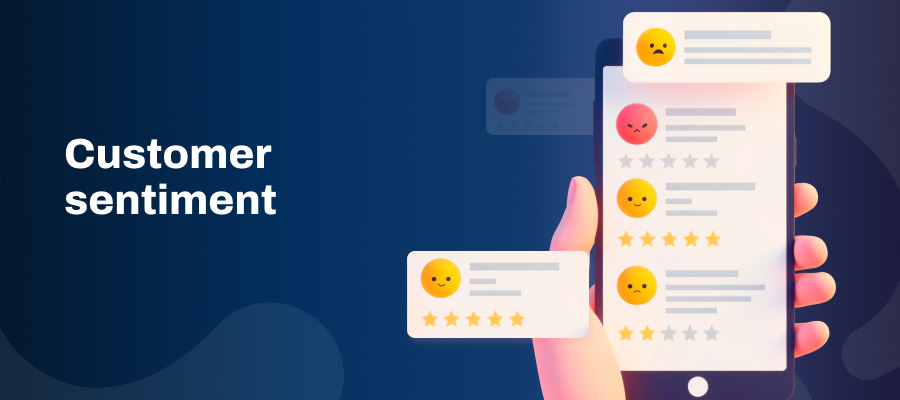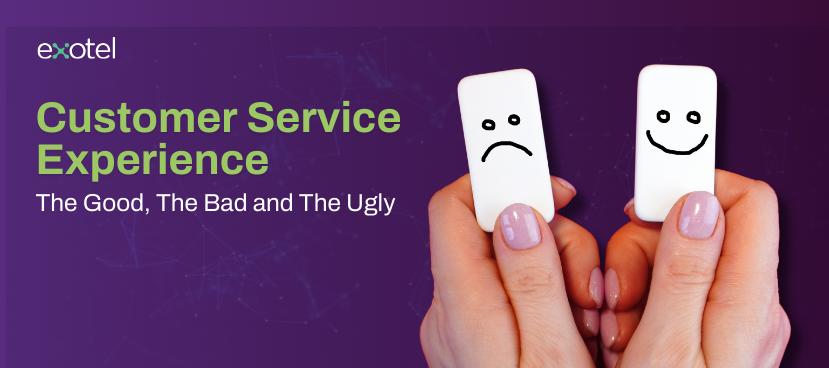How do your customers really feel about your brand?
You might track sales, website traffic, or social media followers. But none of those tell you the whole story.
Companies that track sentiment closely outperform those that don’t. According to Forrester’s 2024 U.S. Customer Experience Index, companies that place customer needs at the center of all decisions achieve 41% faster revenue growth and 51% better customer retention than their competitors.
In this blog, you’ll learn customer sentiment and practical ways to measure it across your key channels.
What is Customer Sentiment?
Customer sentiment is the emotion behind your customer’s words and actions. It shows whether they feel happy, frustrated, loyal, or disappointed.
It’s not the same as asking if someone is “satisfied.” Sentiment digs deeper and captures emotions across every interaction, such as calls, chats, emails, reviews, or social media posts.
Think about a time you contacted customer support. Were you relieved after getting help? Or angry because it took too long? That feeling is customer sentiment in action.
Ignoring sentiment puts you at risk. A Zendesk study found that 61% of customers will switch to a competitor after multiple bad experiences.
What is Customer Sentiment Analysis?
Customer sentiment analysis evaluates customers’ opinions, emotions, and attitudes based on their written or spoken feedback.
The feedback can be gathered from various sources, such as surveys, social media posts, and support interactions.
This helps businesses identify patterns and trends in customer sentiment to make informed decisions to improve customer experience and satisfaction.
For example, if sentiment analysis reveals a surge in negative feedback following a product update, a company can promptly investigate and address the issues.
Benefits of Customer Sentiment Analysis
1. Understand Customer Needs and Expectations Better
Sentiment analysis highlights what your customers truly care about. For example, if support chats show repeated frustration about pricing, you know where to focus next. It removes the guesswork from your decisions.
2. Proactive Resolution of Customer Problems
You don’t need to wait for complaints to pile up. If sentiment turns negative after a product update, you can step in quickly before it impacts retention. It’s about spotting issues early and acting fast.
3. Improved Brand Reputation
People talk, especially when they’re unhappy. If you catch negative sentiment on social media or in reviews, you can respond in real time and protect your brand. Brands that listen build trust.
4. Enhanced Team Performance
Sentiment insights show you how customers feel after interacting with your team. If one agent consistently gets positive feedback, study what they’re doing right. Use that data to train others.
5. Guides Improvement for Products and Services
Are customers excited about a new feature or frustrated by a recent change? Sentiment data tells you. You can prioritize product updates based on real emotions, not assumptions.
How to Measure Customer Sentiment?
You can’t manage what you don’t measure. You need to track sentiment across the right touchpoints to understand how your customers truly feel. Here are some ways to measure it:
1. AI-Powered Tools
Use AI to analyze customer conversations, reviews, and survey responses. These tools scan large volumes of text and detect emotional tones such as positive, negative, or neutral. You get fast, actionable insights without manual work. It helps you spot trends and emotional shifts across thousands of customer interactions.
2. Customer Service Software
Modern support tools like Exotel now include sentiment tracking built into ticketing systems. They analyze ongoing interactions and flag negative sentiment during chats, calls, or emails. Your team can respond faster, escalate if needed, and reduce customer frustration.
3. Social Media Monitoring
Social platforms are often the first place customers express how they feel. Monitoring tools can analyze the tone in mentions, comments, and hashtags. You can spot growing frustration, praise, or confusion in real-time and take action before it spreads.
How to do it:
- Track brand mentions, tagged or untagged, across major platforms
- Monitor keywords related to your product, service, or industry
- Analyze sentiment in comments, replies, and reviews regularly
- Set up alerts for spikes in negative or unusual activity
- Respond quickly to concerns or complaints to contain issues early
4. Direct Feedback
Ask open-ended questions in surveys, chat follow-ups, or emails. This lets customers explain their feelings in their own words. Analyzing that feedback helps you understand what made them happy, annoyed, or likely to return or not.
How to do it:
- Include open-text fields in post-interaction surveys
- Ask specific questions like “What could we have done better?”
- Review chat and email transcripts to identify emotional tone
- Group feedback by themes (e.g., pricing, support, product issues)
- Use keyword analysis to find recurring praise or complaints
5. Net Promoter Scores (NPS)
NPS asks customers how likely they are to recommend your business. But the real insight comes from their written comments. Tracking patterns in that feedback helps you understand the emotional drivers behind loyalty or dissatisfaction and improve based on real experiences.
How to do it:
- Run NPS surveys regularly across key customer journeys
- Analyze qualitative feedback from both promoters and detractors
- Tag common themes in comments (e.g., speed, support, value)
- Compare sentiment trends across NPS segments
- Use findings to prioritize product or service improvements
How to Improve Customer Sentiment?
Tracking sentiment is just the start. Real improvement happens when you act on those insights. Here are some ways to do it:
1. Analyze Trends to Make Predictions and Forecasts
Review sentiment over time across calls, emails, reviews, and chats. If negative feedback spikes after a pricing change, that’s a red flag. For example, if support sentiment dips every weekend, you may be understaffed. Use this data to forecast churn, spot recurring issues, and fix them before they impact retention.
2. Send Instant Insights to your Team
Don’t wait for monthly reports. Set up automatic alerts when negative sentiment shows up in tickets or reviews. For example, if a customer says “frustrated” or “waste of time,” route that to a manager immediately. Quick action often leads to faster resolution and stronger trust.
3. Train Your Staff with Targeted Strategies
Track which team members consistently get positive or negative feedback. For instance, if one agent receives high sentiment scores, use their calls as training material. If another struggles, review their conversations and coach them on tone, clarity, and empathy. Personalized training leads to better customer interactions and better sentiment.
How to Turn Sentiment Data into Actionable Insights
Collecting sentiment data is only valid if you act on it. Not every emotion signals a problem, but patterns in the data can help you fix what’s broken and double down on what’s working. Use the insights to guide your next steps.
Tips to make your sentiment data more actionable:
» Identify recurring issues in the data. Map them by category to identify problems that need urgent attention.
» Break down sentiment by customer type. Filter it using CSAT scores, loyalty, or demographics to see who’s satisfied and who isn’t.
» Track how sentiment shifts over time. Look for patterns around product updates, marketing campaigns, or service changes.
Choose the methods that align with your goals. The more targeted your analysis, the clearer your next move will be.
Know Exactly What Your Customers Want with Exotel
Guessing what your customers want leads to missed opportunities. With Exotel, you don’t have to guess.
Exotel gives you access to real-time customer sentiment across calls, messages, and chats. You can track customers’ feelings after every interaction and spot issues before they turn into churn.
Want to know which agent makes your customers feel heard? Or which product feature frustrates them the most? Exotel shows you. Use sentiment insights to improve your service, coach your team, and make smarter product decisions.
Are you ready to hear what your customers really say? Book a demo with Exotel today.
Frequently Asked Questions (FAQs)
1. What’s the Difference Between Customer Sentiment and Customer Satisfaction?
Customer satisfaction measures how happy someone is with a specific interaction. Sentiment reveals the emotional tone behind their overall experience or opinion.
2. How Can I Measure Customer Sentiment Accurately?
Use a mix of AI tools, customer service platforms, social media monitoring, direct feedback, and NPS data to get a full picture of how your customers feel.
3. How Often Should I Track Customer Sentiment?
Regularly. Ideally, after key interactions like support calls, product updates, or purchases. Tracking over time helps you spot trends and act fast.





